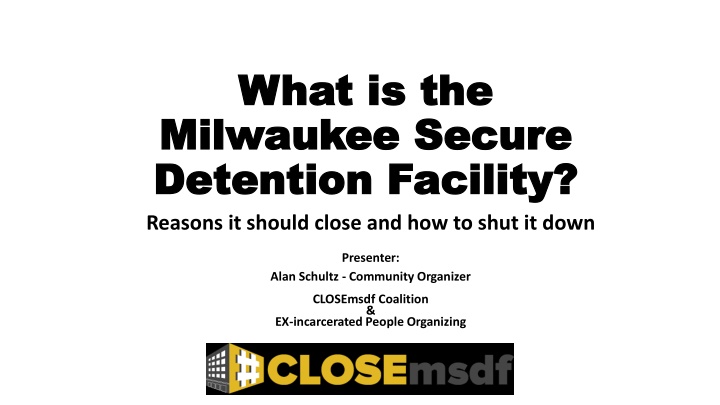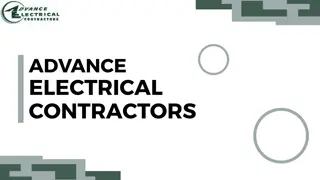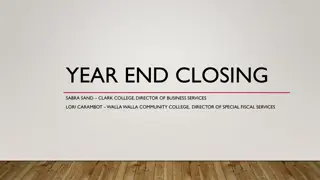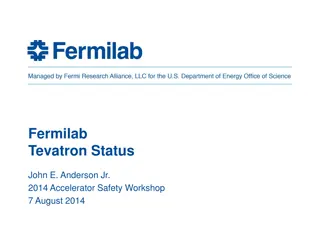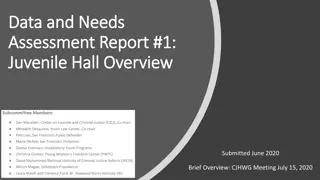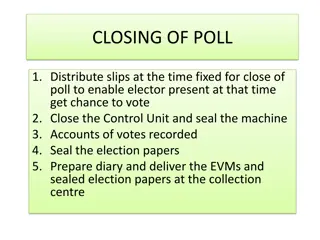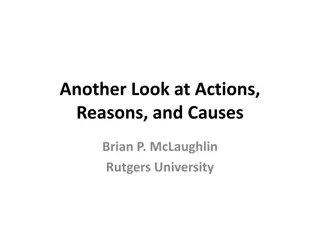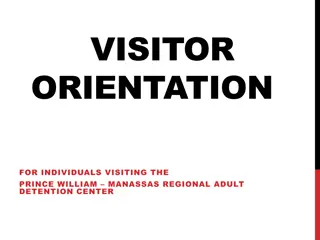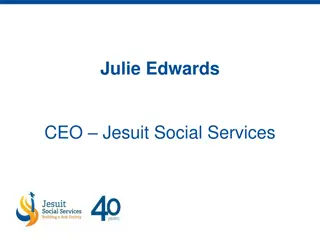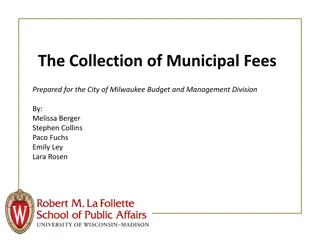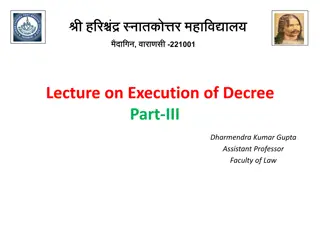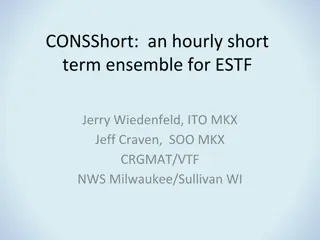Closing the Milwaukee Secure Detention Facility: Reasons and Actions
The Milwaukee Secure Detention Facility (MSDF) has been a controversial institution used to confine individuals on probation, parole, or extended supervision. This piece delves into the origins of MSDF, its current use, inhumane conditions, and the push by advocates to shut it down. Understand the motivations behind the closure efforts led by the community coalition and those who have experienced incarceration. Learn about the racial disparities, lack of proper mental health treatment, and the harm caused to both inmates and the wider community. Discover the blueprint for closing MSDF and why it is a crucial step towards justice.
Download Presentation

Please find below an Image/Link to download the presentation.
The content on the website is provided AS IS for your information and personal use only. It may not be sold, licensed, or shared on other websites without obtaining consent from the author.If you encounter any issues during the download, it is possible that the publisher has removed the file from their server.
You are allowed to download the files provided on this website for personal or commercial use, subject to the condition that they are used lawfully. All files are the property of their respective owners.
The content on the website is provided AS IS for your information and personal use only. It may not be sold, licensed, or shared on other websites without obtaining consent from the author.
E N D
Presentation Transcript
What is the What is the Milwaukee Secure Milwaukee Secure Detention Facility? Detention Facility? Reasons it should close and how to shut it down Presenter: Alan Schultz - Community Organizer CLOSEmsdf Coalition & EX-incarcerated People Organizing
Overview Overview What is MSDF (Milwaukee Secure Detention Facility)? Who is at MSDF? Revocations Convictionless/Crimeless Revocations Racial Disparity Mental Health Treatment Alternatives & Diversions (TAD) Inhumane Conditions at MSDF Harm Caused to Incarcerated People & the Community Blueprint for Closing MSDF
WHAT IS MSDF? WHAT IS MSDF? (Milwaukee Secure Detention Facility (Milwaukee Secure Detention Facility) ) History Current Use Structure/Operation
ORIGIN OF MSDF ORIGIN OF MSDF Wisconsin built MSDF in 2001 to house roughly 460 people on probation, parole, or extended supervision who allegedly violated rules of supervision for 60 to 90 day periods of confinement. The impetus for its construction was overcrowding of the Milwaukee County Jail and Franklin House of Corrections in the late 90s resulting in the Milwaukee Sheriff at the time to pursue filing a lawsuit against the state of Wisconsin due to the overcrowding of facilities under their purview. The Sheriff won the suit and MSDF was subsequently constructed.
CURRENT USE OF MSDF CURRENT USE OF MSDF Today, Wisconsin continues to use MSDF to unnecessarily incarcerate thousands of people who have not been convicted of new crimes. The state s DOC forces many people to spend long periods of time in this institution due to being waitlisted for programs for months. Thus, stalling one s expedient release which is predicated on completion of an underfunded and/or understaffed program. The facility is also used as a holding facility while people are investigated for community supervision (extended supervision/parole) violation allegations, are awaiting transfer to Dodge Correctional Institution (Assessment & Evaluation is completed here for intake of all state incarcerated people), are serving the remainder of a smaller sentence (usually under 2 years) after having their community supervision revocated, and/or are awaiting entrance or already in an Alternative-To-Revocation (ATR) program.
STUCTURE/OPERATION OF MSDF STUCTURE/OPERATION OF MSDF MSDF is a high-rise prison in downtown Milwaukee. MSDF is a building within a building. There is no direct sunlight, no air conditioning, and no outdoor recreation. The current operating capacity is 1,040, but it was designed to be closer to 400 people. To accommodate overcrowding, they started putting two or three people in cells designed for one. Prisoners at MSDF spend more than 20 hours a day (some up to 23 or 24) in their cells. In triple-bunked cells, one person has to sleep on the floor beside the toilet in a pull out boat stored under the bunk bed. Disease runs rampant and healthcare especially mental health treatment is totally inadequate. At least 17 people have died inside MSDF since it was built in 2001. There is only minimal drug and alcohol treatment for a fraction (240) of the prisoners, and no in-person visits. Family contact is widely known to be the best means to avoid recidivism, but MSDF requires visitors to come through security just to talk with their loved ones through often malfunctioning video monitors.
WHO IS AT MSDF? WHO IS AT MSDF? 66% of people incarcerated at MSDF at the end of 2016 were Black identifying. (While Black people only constitute 7% of Wisconsin s entire population) 32% identify as white at MSDF - 2016 report (While white people constitute 88% of Wisconsin s entire population) 2% are Native American/Indigenous identifying - 2016 report (While indigenous people constitute roughly 1% of Wisconsin s entire population) Many people at MSDF have disabling physical or mental conditions. Many people at MSDF have substance abuse problems. MSDF has a 40 bed pod for women on the 6th floor. The 7th and 8th floors house up to 400 men who are either on a probation/parole hold or awaiting transfer to Dodge Correctional Institution or MSDF DAI housing. The 9th floor houses 200 Division of Adult Institution (DAI) people who have been revocated and are normally serving 12 months or less confinement time. MSDF has 224 beds for people who are in 60 to 90 day alternative to revocation treatment programs. Other people are housed in special needs units, orientation pods, or segregation pods.
REVOCATION REVOCATION Revocation being incarcerated for breaking the rules of a supervision arrangement (like parole, probation, or extended supervision) which feeds the mass incarceration cycle. Estimates suggest that across the U.S., half of the people in jails and more than one-third of the people entering prison are locked up for a revocation. Wisconsin s community supervision (probation/parole/extended supervision) rate is nearly 50% higher than the national average. The state reincarcerates people on parole at a rate that is also nearly 50% above the national average. Between 2000 and 2008, overall prison admissions in the state increased by 19%, according to a report from the Wisconsin Department of Corrections (DOC). Around the same time, revocation-only admissions doubled. Though these rates have decreased slightly since, there were almost 3,300 revocation-only admissions in 2016.
CONVICTIONLESS/CRIMELESS CONVICTIONLESS/CRIMELESS REVOCATIONS REVOCATIONS In Wisconsin, the Department of Corrections (DOC) put about 3,000 people in prison in 2015 alone for what DOC calls a revocation without a new offense, meaning there was not a new criminal conviction. A large number of people are incarcerated for breaking the rules of supervision, but do not commit a new crime. These people will serve an average of 18 months in prison without being convicted of a new crime and cost Wisconsin $147.5 million dollars in the process. Taxpayers spend $40 million on MSDF every year, that s over $100 per incarcerated person per day. This means that there are about 4,500 people in Wisconsin state prisons who were sent back for rule violations rather than because of a conviction for a new crime. This is more than the combined capacity of MSDF and Wisconsin s two largest prisons. Over 1/3rd of Wisconsin prison admissions are revocations without a new conviction. Between July of 2016 and June of 2017 Wisconsin cycled 5,423 people through MSDF, many on crimeless revocations.
RACIAL DISPARITY AT MSDF RACIAL DISPARITY AT MSDF Black identifying people were 12 times more likely to be sent to prison for crimeless revocations than white identifying people in 2013 (compared to the general population). Two out of every five people put in prison for a revocation without a new criminal conviction in 2015 identified as Black (40%) yet only 6.6% of the Wisconsin population identifies as Black. The high rate of crimeless revocations among Black men helps explain why Wisconsin imprisons Black men at a higher rate than any other state. Although Black men constitute just 5% of adult men in Wisconsin, they accounted for 39% of all crimeless revocations in 2014.
MENTAL HEALTH AT MSDF MENTAL HEALTH AT MSDF According to a March 2015 study by the Urban Institute, an estimated 56 percent of state prisoners, 45 percent of federal prisoners, and 64 percent of jail inmates have one or more psychological disorders. 62% of the incarcerated population at MSDF have a mental health diagnosis Nearly half of people put in prison for a revocation had a mental health condition Each year of incarceration is associated with a 2 year decrease in life expectancy. Nearly half of people put in prison for a revocation without a new criminal conviction have a mental health condition (44%) when Wisconsin has an 18% prevalence of mental health conditions. In a state with too few rehabilitative programs as alternatives to incarceration, these inequities contribute to significant barriers for people to reach their full health and human potential. According to the Wisconsin Department of Corrections, the average cost of putting someone behind bars for one year was about $32,000 (In 2011, according to the Vera Institute today it is $38,644). But a state report evaluating TAD s first four years found that even in the most expensive alternative programs, the average annual cost per participant is $7,551. The Wisconsin Office of Justice Assistance estimates that every dollar spent on treatment alternative programs saves almost $2 in criminal justice costs. By that yardstick alone, increased investment of $75 million in alternatives to prison would yield an annual savings of almost $150 million.
TREATMENT ALTERNATIVES & TREATMENT ALTERNATIVES & DIVERSIONS DIVERSIONS We found overwhelming evidence that expanding alternatives to incarceration would reduce the prison population, reduce crime, lower recidivism, and strengthen families by keeping up to 1,600 parents a year out of prison each year. Because the cost of treatment is about one-fourth of the cost of putting someone behind bars, the state would also save up to $2 for every dollar spent on alternative treatment programs.
INHUMANE CONDITIONS AT MSDF INHUMANE CONDITIONS AT MSDF Frequent Suicide Attempts and Suicides Self-Mutilation Fights 3 people confined to single and double occupancy cells (one person is often in a plastic sled on the floor in front of the toilet) Locked down in cells for 20 to 23 hours a day (24 if on modified confinement or for Training Days ) Cannot see outside or go outside/no ability access sunlight Poor and unresponsive health care No in-person visits No outdoor recreation Poor ventilation Extreme heat 17 people have died there since it opened October 8th, 2001
HARM CAUSED TO INCARCERATED HARM CAUSED TO INCARCERATED PEOPLE AND THE COMMUNITY PEOPLE AND THE COMMUNITY Revocation affects employment and housing. The stress and stigma of incarceration and supervision affect health. When a parent is incarcerated, families pay a price. Revocation processes are applied inconsistently in Wisconsin Incarcerating people for breaking the rules of supervision doesn t improve public safety.
Revocation affects employment and housing. Revocation affects employment and housing. Employment and housing are particularly important for people s successful re-entry after release from incarceration. For people on supervision, time incarcerated while the state investigates and decides on an allegation or revocation means time away from work. This can lead to loss of income, making it harder to pay for basic needs like housing or childcare. It can even mean losing jobs a challenge for people that evidence shows already face considerable barriers in getting a job. Ironically, employment and stable housing are often part of the rules of supervision. A person may risk a revocation if they don t have steady employment or stable housing.
The stress and stigma of incarceration and The stress and stigma of incarceration and supervision affect health. supervision affect health. It can damage health when stressful situations consistently overwhelm a person s ability to cope particularly when a person feels they have little control over these situations. Imprisonment is an acute stressor, as a major disruption in a person s life. It is also a chronic stressor that may involve daily exposure to violence or threats, hostile relationships with guards and other incarcerated people, overcrowding, and a lack of privacy and control. After release from incarceration, people remain marked by the stigma of a conviction and can face secondary stressors as they work towards rehabilitation including the constant threat of revocation.
When a parent is incarcerated, families pay a price. When a parent is incarcerated, families pay a price. Nearly half of people put in prison for a revocation without a new criminal conviction in 2015 were parents (48%). The impacts of incarceration extend beyond the people locked up and are associated with wide ranging detrimental effects on children and families. The report finds that incarcerating people for revocation without being convicted of a new crime in 2015 put an estimated 2,700 kids at increased risk of poverty with a father s incarceration, and 1,600 kids in Wisconsin may have lost primary financial support with any parent s incarceration.
Revocation processes are applied inconsistently Revocation processes are applied inconsistently in Wisconsin in Wisconsin The Department of Corrections has yet to clearly implement the state law calling on it to create short-term responses for people who break the rules of supervision and to determine how to reward people under supervision for compliance. Current practice is inconsistent and there is too little training, lack of written policy, and opportunity to improve Department data collection.
Incarcerating people for breaking the rules of Incarcerating people for breaking the rules of supervision doesn t improve public safety. supervision doesn t improve public safety. Research shows that violating what are known as technical rules of supervision is not a good indicator of new crime, and that incarcerating people for technical rule violations may increase recidivism making the possibility of a person committing a future crime more likely.
BLUEPRINT FOR CLOSING MSDF BLUEPRINT FOR CLOSING MSDF Remove incarceration as a response to non-compliance for non-criminal violations of the rules of parole, probation or extended supervision. End the practice of incarcerating people for minor rule violations of their supervision. Wisconsin must overhaul supervision laws and abolish the use of incarceration for crimeless rule violations. Wisconsin must immediately depopulate, shut down, and demolish MSDF. It is an unsafe environment for anyone, including people who work there. Depopulate and close the Milwaukee Secure Detention Facility. Reinvest the excessive corrections spending toward workforce development training for formerly incarcerated people and greater access to mental health professionals and clinics within the community. We aim to reimagine how we invest in and serve the people who have been impacted by the justice system and their families and communities. We seek to repair the harm created by Wisconsin s penal system.
End the practice of incarcerating people for End the practice of incarcerating people for minor rule violations of their supervision. minor rule violations of their supervision. Allow people facing revocation to remain in the community until their hearings. As an alternative measure to revocation for people on parole, probation, or extended supervision: continue to build on the partially implemented steps of the short-term sanctions law, by ensuring a consistent and racially equitable response to non-compliance and the granting of rewards for compliance that is transparently documented, through policy development, clear matrices, and workforce development that includes annual trainings. Consistently track, evaluate at regular intervals, and annually disseminate the outcomes on the use of alternative measures to revocation for people on parole, probation or extended supervision to build community trust. As an alternative to revocation, provide access and navigation into rehabilitative programs and assure successful graduation for people on parole, probation or extended supervision. Shift the Alternatives to Revocation beds to the community. Reduce the number of people and length of time people across races/ethnicities are placed on probation or extended supervision, which will in turn reduce agency caseloads. Apply greater due process rights for people in revocations investigations and proceedings, such as right to bail and a higher standard of evidence.
Wisconsin must immediately depopulate, Wisconsin must immediately depopulate, shut down, and demolish MSDF. shut down, and demolish MSDF. Solve overcrowding, short staffing, and overall ballooning financial issues in Wisconsin jails and prisons through policy changes such as bail reform and increased use of Treatment Alternatives and Diversion programs.
Reinvest the excessive corrections spending Reinvest the excessive corrections spending toward workforce development training toward workforce development training for formerly incarcerated people for formerly incarcerated people and greater access to mental health and greater access to mental health professionals and clinics professionals and clinics within the community. within the community. We aim to reimagine how we invest in and serve the people who have been impacted by the justice system and their families and communities. We seek to repair the harm created by Wisconsin s penal system.
Source Material Source Material www.CLOSEmsdf.org https://humanimpact.org/hipprojects/treatment-instead-of-prison- hia-case-story/ https://humanimpact.org/hipprojects/sent-back/?strategy=all https://www.wjawi.org/2016/01/20/the-challenges-of-incarcerating- mentally-ill-inmates/ http://justicelab.iserp.columbia.edu/img/Too_Big_to_Succeed_Repor t_FINAL.pdf https://www.justice.gov/usao-edwi/page/file/1012831/download
CLOSEmsdf CLOSEmsdf Leadership Development Training Leadership Development Training WHERE: Welford Sander Center 2821 N. Vel Phillips Avenue Suite 108, Milwaukee, WI 53212 WHEN: Saturday, October 13th, 2018 from 10am to 4pm WHAT: A training to become a more effective leader, fellowship with other people working for justice, and a chance to learn about the #CLOSEmsdf Campaign and how to be a part of it The training is free of charge and includes lunch and snacks. For more information contact Mark Rice (608)-843-0171 VISIT: CLOSEmsdf.org
